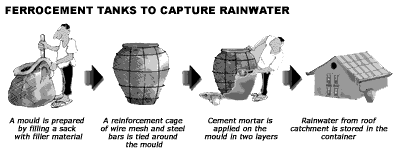| Ferrocement Fundamentals |
| Ferrocement consists of a thin sheet of cement mortar which is
reinforced with a cage made of wire mesh and steel bars. Because ferrocement is
structurally more effectient than masonry, the thickness of the walls of the container are
as low as 10 to 15 mm. Ferrocement components can be casted in any shape using
suitable mouolds. The technology is extremely simple to implement, and even
semi-skilled workpersons can learn it with ease. Ferrocement requires only a few
easily available materials - cement, sand, galvanized iron (GI) wire mesh, and mild steel
(MS) bars - in small amounts compared to masonry and RCC. |
One of the primary requirements of a water harvesting system is that of
containers to store the harvested water in a hygienic condition. This need is more
pronounced in high-rainfall areas, where it is more feasible to store water in containers
for direct use, rather than for recharging the groundwater. Generally, in small domestic
systems, the cost of constructing tanks with conventional materials like masonry or RCC is
far more than that of the rainwater collection and piping component. Ferrocement can
provide a low-cost and easy-to-build solution to the need for low-cost containers. This
technology is particularly relevant for regions like Meghalaya, Arunachal Pradesh and
Kerala, which have high frequency of rainfall.
The Structural Engineering Research Centre (SERC), Ghaziabad, has done
research and development on a large number of low-cost structures and implements like
water/grain storage containers, irrigation channels, biogas digesters and septic tanks,
primarily using ferrocement. SERC scientists are imparting training in ferrocement
technology to rural artisans under the National Drinking Water Mission.
Ferrocement containers can be used to store grain and seed, apart from
water. Tanks of 1000-2000 litre capacity can be constructed with ease, which are much
cheaper than masonry, RCC or plastic tanks. These are easy to repair, and can be easily
transported because of their sturdy nature. Such containers have been used on a wide scale
since about the past 25 years in Thailand, Malaysia and some African countries.
Ferrocement containers with capacity as much as 5000 litres have been constructed in
Thailand.
The process of building a ferrocement container is very simple which
users can do themselves, with some training. For a typical circular pot-shaped container,
the only materials required are hessian cloth, chaff (waste from agricultural produce), GI
wire mesh, MS bars, cement and sand.
To prepare the mould, the hessian cloth, stitched into a sack
resembling the shape of the container, is filled with chaff that is compacted in layers.
Dry leaves or dry grass can be used in place of chaff. Once the sack is filled with the
filler material, it is beaten into the required shape by a wooden bat. A GI wire mesh
(22-26 guage - see Table 1) is tied around the mould leaving sockets at suitable locations
for inlet, overflow and cleaning pipes. Tying 6 mm diameter mild steel (MS) bars at wide
intervals both horizontally and vertically strengthens the reinforcement cage.
| Table 1: Parameters for various capacities of
ferrocement containers |
| Capacity (ltrs) |
Thickness of walls (mm) |
Ratio cement:sand |
Thickness of GI wire (guage) |
| 400 |
10 |
1:3 |
26 |
| 600 |
10 |
1:3 |
24 |
| 900 |
12 |
1:2.5 |
24 |
| 1500 |
15 |
1:2.5 |
22 |
Once the reinforcement cage is tied, cement mortar having cement-sand
proportion of 1:2.5 or 1:3 (see Table 1) is prepared, having water content equal to 0.45
times the volume of cement. The mortar is plastered in two layers along the wall
thickness, the second layer being applied 24 hours after the first. The ferrocement wall
normally has a thickness of 10 to 15 mm, depending on the volume of the container (see
Table 1). The cement mortar is applied ensuring a minimum clearance (cover) of 3 mm
between the reinforcement mesh and the outer surfaces of the wall. The mould of the
container is removed 24 hours after casting of the walls is completed, by removing the
filler material, and the container can be brought into use after 10 days of wet curing.
SERC has developed large capacity ferrocement rooftop water collectors
of upto 10,000 litres.
Source: Sharma, P, "Ferrocement Bhandaran Patra (Ferrocement Storage Tanks)
- National Drinking Water Mission", SERC, Ghaziabad, 1990 |






